| |
Language
Glossary | Flower Glossary
Flower Glossary
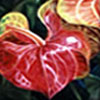 Anthurium,
Red (Anthurium Andraeanum) –
When we think of Anthuriums,
we usually think of a red, heart-shaped blossom. Not only do Anthuriums
come in many forms and colors, but the heart-shaped “flower”
is really a spathe, or waxy, modified leaf flaring from the base
of a fleshy spike of tiny flowers.
<http://www.cafeshops.com/anthurium>. Anthurium,
Red (Anthurium Andraeanum) –
When we think of Anthuriums,
we usually think of a red, heart-shaped blossom. Not only do Anthuriums
come in many forms and colors, but the heart-shaped “flower”
is really a spathe, or waxy, modified leaf flaring from the base
of a fleshy spike of tiny flowers.
<http://www.cafeshops.com/anthurium>.
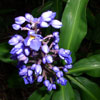 Blue
Ginger (Dichorisandra Thyrsiflora) – The blue ginger
(Dichorisandra thyrsiflora J.C. Mikan) is a member of the Commelinaceae,
the family of spiderworts. The leaves are arranged spirally around
the stem. The inflorescence is a terminal thyrse, a panicle with
an indeterminate central axis. As long as conditions are conducive
to blooming, the thyrse will continue to expand upward adding
flower buds at the top. The flowers have three light blue sepals,
three dark blue petals, and six stamens. (American
Journal of Botany87(9), 2000). Blue
Ginger (Dichorisandra Thyrsiflora) – The blue ginger
(Dichorisandra thyrsiflora J.C. Mikan) is a member of the Commelinaceae,
the family of spiderworts. The leaves are arranged spirally around
the stem. The inflorescence is a terminal thyrse, a panicle with
an indeterminate central axis. As long as conditions are conducive
to blooming, the thyrse will continue to expand upward adding
flower buds at the top. The flowers have three light blue sepals,
three dark blue petals, and six stamens. (American
Journal of Botany87(9), 2000).
<http://www.killerplants.com/plant-of-the-week/20031124.asp>.
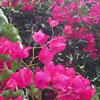 Bougainvillea
(Nyctaginacaeae genus) – Bougainvillea belongs to the
Nyctaginacaeae family and has 250 species. However, only two or
three species are usually grown. The Bougainvillea flowers throughout
the year and the flowers come in a medley of colors. The brightly
colored papery flowers are actually bracts sheathing the slender
stem. The true flowers which are enclosed by the bracts are small,
white and trumpet shaped. Bougainvillea
(Nyctaginacaeae genus) – Bougainvillea belongs to the
Nyctaginacaeae family and has 250 species. However, only two or
three species are usually grown. The Bougainvillea flowers throughout
the year and the flowers come in a medley of colors. The brightly
colored papery flowers are actually bracts sheathing the slender
stem. The true flowers which are enclosed by the bracts are small,
white and trumpet shaped.
<http://agrolink.moa.my/comoditi/flower/bkertas.html>.
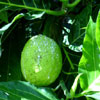 Breadfruit
(Artocarpus altilis) – The breadfruit tree is handsome
and fast growing, reaching 85 ft (26 m) in height, often with
a clear trunk to 20 ft (6 m) becoming 2 to 6 ft (0.6-1.8 m) in
width and often buttressed at the base, though some varieties
may never exceed 1/4 or 1/2 of these dimensions. The leaves are
bright-green and glossy on the upper surface, with conspicuous
yellow veins; dull, yellowish and coated with minute, stiff hairs
on the underside. The tree bears a multitude of tiny flowers. Breadfruit
(Artocarpus altilis) – The breadfruit tree is handsome
and fast growing, reaching 85 ft (26 m) in height, often with
a clear trunk to 20 ft (6 m) becoming 2 to 6 ft (0.6-1.8 m) in
width and often buttressed at the base, though some varieties
may never exceed 1/4 or 1/2 of these dimensions. The leaves are
bright-green and glossy on the upper surface, with conspicuous
yellow veins; dull, yellowish and coated with minute, stiff hairs
on the underside. The tree bears a multitude of tiny flowers.
<http://www.hort.purdue.edu/newcrop/morton/breadfruit.html>.
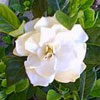 Gardenia
(Gardenia Jasminoides) – Gardenia Jasminoides or Common
Gardenia or Cape Jasmine is an evergreen shrub, which grows to
a height of 2 to 6 feet, depending on the variety. Spread is about
the same. The foliage of well-fed shrubs is glossy, dark-green,
2 to 4 inches long and half as wide. Gardenia
(Gardenia Jasminoides) – Gardenia Jasminoides or Common
Gardenia or Cape Jasmine is an evergreen shrub, which grows to
a height of 2 to 6 feet, depending on the variety. Spread is about
the same. The foliage of well-fed shrubs is glossy, dark-green,
2 to 4 inches long and half as wide.
<http://www.desert-tropicals.com/Plants/Rubiaceae/Gardenia_jasminoides.html>.
 Ginger,
Butterfly (Zingiberacea) – Erect herb with stems to 1
m tall; leaves distichous, narrowly oblong or lanceolate, acuminate,
about 50-60 cm long, 10 cm wide, petiole short; flowers white,
yellowish in age, sweetly fragrant, to 6-8 cm long, the tube very
slender, inflorescences dense spike-like, terminal, bracteate;
bracts oblong-obovate or oblong, imbricate. Favors wet habitats.
Rainforest, moist forest, roadsides, open areas, stream-sides.
Creeping growth overwhelms low growing plants in pastures and
forests (Motooka et al., 2002). In Hawaii, frequently cultivated
and naturalized in mesic forest" (Wagner et al., 1999). Ginger,
Butterfly (Zingiberacea) – Erect herb with stems to 1
m tall; leaves distichous, narrowly oblong or lanceolate, acuminate,
about 50-60 cm long, 10 cm wide, petiole short; flowers white,
yellowish in age, sweetly fragrant, to 6-8 cm long, the tube very
slender, inflorescences dense spike-like, terminal, bracteate;
bracts oblong-obovate or oblong, imbricate. Favors wet habitats.
Rainforest, moist forest, roadsides, open areas, stream-sides.
Creeping growth overwhelms low growing plants in pastures and
forests (Motooka et al., 2002). In Hawaii, frequently cultivated
and naturalized in mesic forest" (Wagner et al., 1999).
<http://www.hear.org/pier/species/hedychium_coronarium.htm>.
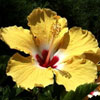 Hibiscus
Blossom (Hibiscus Rosa-Sinensis) – “Pua Aloalo”
The hibiscus plant can reach up to a height of 6m if not
pruned. The stem surface is smooth and the leaves are simple and
alternate. Their shape and size vary greatly, even on the
same branch. They can be entire, but often they are lobed or deeply
divided. The floral structure consists of five petals surrounding
a central staminal column. The ovary consists of five carpels
and numerous stamens are joined together to form the staminal
column, through the center of which passes the single style. The
style in turn ends in five stylar branches with stigmas at their
tips, one for each of the five carpels in the ovary. These branches
project from the end of the column in most exotic garden hibiscus.
The color of the flowers are red, white, pink, yellow and maroon. Hibiscus
Blossom (Hibiscus Rosa-Sinensis) – “Pua Aloalo”
The hibiscus plant can reach up to a height of 6m if not
pruned. The stem surface is smooth and the leaves are simple and
alternate. Their shape and size vary greatly, even on the
same branch. They can be entire, but often they are lobed or deeply
divided. The floral structure consists of five petals surrounding
a central staminal column. The ovary consists of five carpels
and numerous stamens are joined together to form the staminal
column, through the center of which passes the single style. The
style in turn ends in five stylar branches with stigmas at their
tips, one for each of the five carpels in the ovary. These branches
project from the end of the column in most exotic garden hibiscus.
The color of the flowers are red, white, pink, yellow and maroon.
<http://agrolink.moa.my/doa/BI/Croptech/botanicalhibiscus.html>.
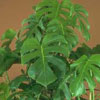 Monstera
Vine (Ceriman/Monstera Deliciosa) – This vine is the
only edible fruit-producing member of the philodendron family.
The fruit looks something like a cross between an ear of corn
and a pine cone and takes up to 18 months to ripen on the plant.
The fruit can be picked after about a year and will start to ripen
several days later. As the fruit ripens from the bottom up, segments
of the inedible outer peel fall off. Monstera
Vine (Ceriman/Monstera Deliciosa) – This vine is the
only edible fruit-producing member of the philodendron family.
The fruit looks something like a cross between an ear of corn
and a pine cone and takes up to 18 months to ripen on the plant.
The fruit can be picked after about a year and will start to ripen
several days later. As the fruit ripens from the bottom up, segments
of the inedible outer peel fall off.
<http://www.echonet.org/eln&herbs/eln_catalog/vines&brambles.htm>.
 Morning
Glory (Calystegia Occidentalis) – Twining perennial,
large creamy-white flowers, beautiful triangular leaves- these
perennial or annual climbing plants come from North America, Asia,
South Africa and the West Indies and have several common names,
one of which is Morning Glory. The twining, climbers grow from
10 to 30 feet high and the bushy Morning Glory forms a mound,
3 to 4 feet high. The leaves are green or variegated silvery white,
ovate or heart-shaped and up to 6 inches across. The flowers are
trumpet-shaped and large, 4 to 5 inches across. They may be pink,
rose, red, white or blue and are often bi-colored with edging,
stripes or flecks. They are sometimes fragrant. Morning
Glory (Calystegia Occidentalis) – Twining perennial,
large creamy-white flowers, beautiful triangular leaves- these
perennial or annual climbing plants come from North America, Asia,
South Africa and the West Indies and have several common names,
one of which is Morning Glory. The twining, climbers grow from
10 to 30 feet high and the bushy Morning Glory forms a mound,
3 to 4 feet high. The leaves are green or variegated silvery white,
ovate or heart-shaped and up to 6 inches across. The flowers are
trumpet-shaped and large, 4 to 5 inches across. They may be pink,
rose, red, white or blue and are often bi-colored with edging,
stripes or flecks. They are sometimes fragrant.
<http://www.botany.com/ipomoea.html>.
 Papaya
(Carica papaya L Caricaceae) – Papayas have exacting
climate requirements for vigorous growth and fruit production.
They must have warmth throughout the year and will be damaged
by light frosts. Brief exposure to 32° F is damaging and prolonged
cold without overhead sprinkling will kill the plants. Cold, wet
soil is almost always lethal. The papaya is a short-lived, fast-growing,
woody, large herb to 10 or 12 feet in height. All parts contain
latex. The hollow green or deep purple trunk is straight and cylindrical
with prominent leaf scars. Its diameter may be from 2 or 3 inches
to over a foot at the base. The leaves emerge directly from the
upper part of the stem in a spiral on nearly horizontal petioles
1 to 3-1/2 feet long. The five-petalled flowers are fleshy, waxy
and slightly fragrant. Papaya
(Carica papaya L Caricaceae) – Papayas have exacting
climate requirements for vigorous growth and fruit production.
They must have warmth throughout the year and will be damaged
by light frosts. Brief exposure to 32° F is damaging and prolonged
cold without overhead sprinkling will kill the plants. Cold, wet
soil is almost always lethal. The papaya is a short-lived, fast-growing,
woody, large herb to 10 or 12 feet in height. All parts contain
latex. The hollow green or deep purple trunk is straight and cylindrical
with prominent leaf scars. Its diameter may be from 2 or 3 inches
to over a foot at the base. The leaves emerge directly from the
upper part of the stem in a spiral on nearly horizontal petioles
1 to 3-1/2 feet long. The five-petalled flowers are fleshy, waxy
and slightly fragrant.
<http://www.crfg.org/pubs/ff/papaya.html>.
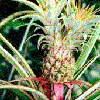 Pineapple
(Ananas comosus Merr) – member of the Bromeliaceae family,
a large, diverse family of 2000 species. The bromeliad family
contains hundreds of taxa used as ornamentals in greenhouses or
sub-tropical areas: Billbergia, Vresia, Nidularium, Pitcairnia,
and Tillandsia. Tillandsia usneoides is "Spanish moss"
native to the Gulf States. Pineapple
(Ananas comosus Merr) – member of the Bromeliaceae family,
a large, diverse family of 2000 species. The bromeliad family
contains hundreds of taxa used as ornamentals in greenhouses or
sub-tropical areas: Billbergia, Vresia, Nidularium, Pitcairnia,
and Tillandsia. Tillandsia usneoides is "Spanish moss"
native to the Gulf States.
<http://www.crfg.org/photocon/1999-4c.html>.
|
|







